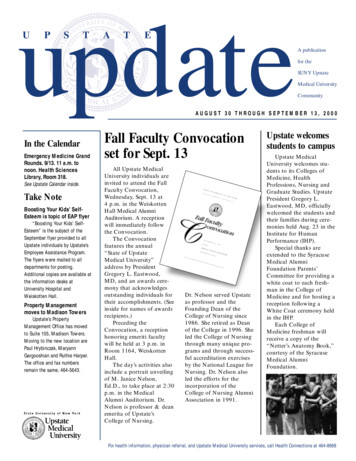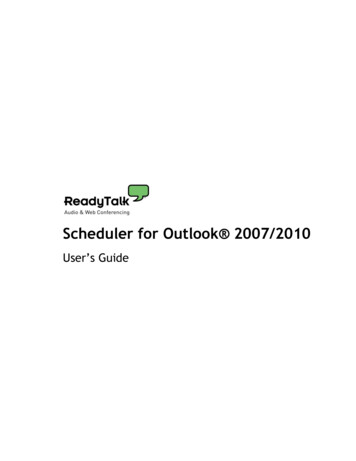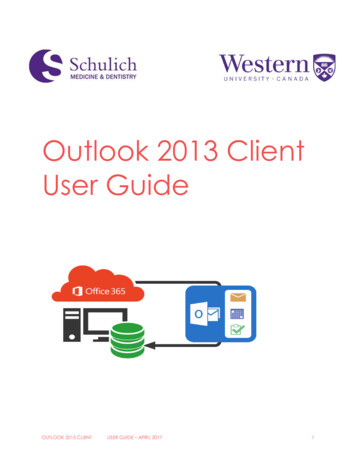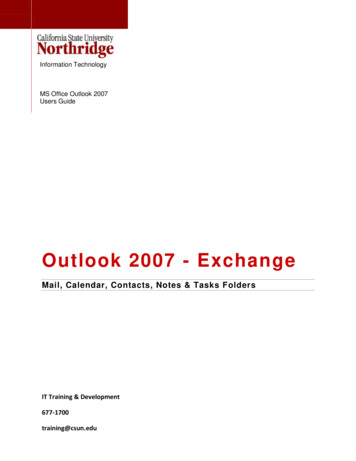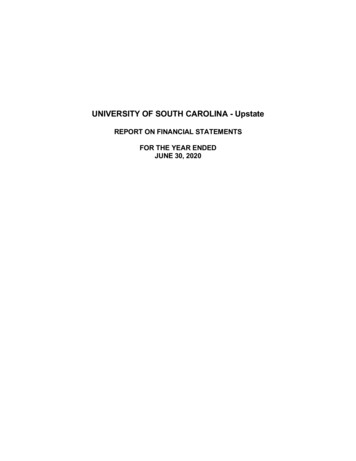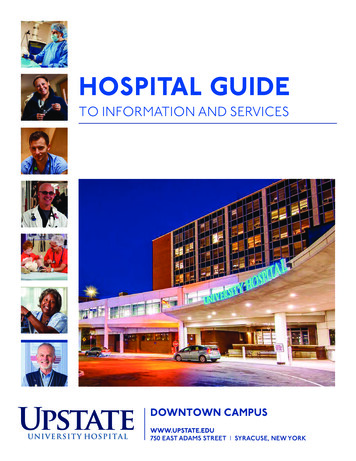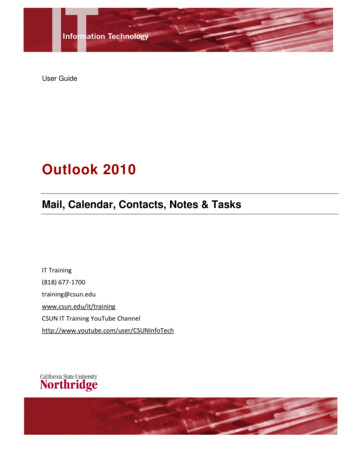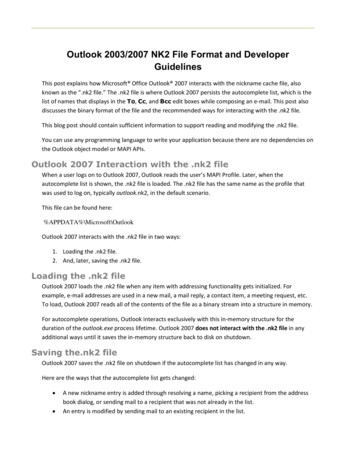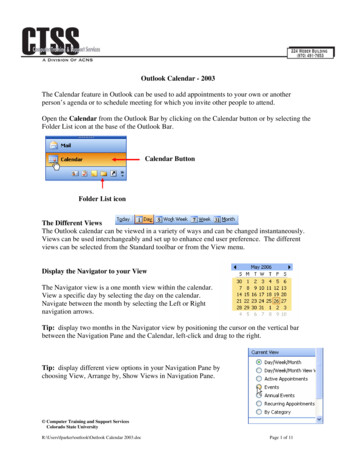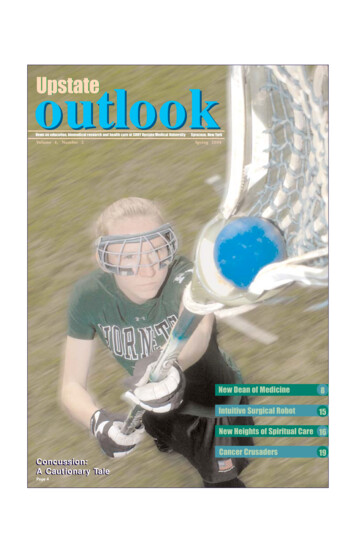
Transcription
UpstateoutlookNews on education, biomedical research and health care at SUNY Upstate Medical UniversityVolume 4, Number 2Syracuse, New YorkSpring 2004New Dean of Medicine8Intuitive Surgical Robot15New Heights of Spiritual Care 16Cancer CrusadersConcussion:Concussion:A CautionaryCautionary TaleTaleAPage 419
Presidential PerspectiveIn addition to inspiring celebration,Dr. Scheinman’s appointment hasprompted some introspection on my part.In the 11 years of my presidency, Upstatehas become dramatically more complex,as evidenced by: an operating budget that has doubledfrom 325M to 650M per year a health care environment that haschanged profoundly funding streams which are increasinglyambiguous an expanding commitment tocollaboration.Over the course of a decade, thesedevelopments have expanded my role aspresident. On a daily basis, I now amcalled upon to interact: with local, state, and national leaders with our nation’s academic medicalcenters, through my activities in theAssociation of Academic Health Centers with our research colleagues inNew York’s promising biotechresearch corridor with our immediate academic neighborson “The Hill’ with our clinical neighbors next dooron Crouse Avenue2The RoadAhead and with Central New York’s citizens,who are demonstrating unprecedentedgenerosity and support of our work,especially in terms of The CNYChildren’s Hospital at UniversityHospital.I thoroughly enjoy these interactionsand feel that great good comes of suchclose collaboration and communication.But this shift in my focus necessitatesinternal shifts in responsibility. To a largedegree, I function as chief executive officer,with continued overall responsibility forthe internal activities of Upstate, but withgreater attention to external affairs.Dr. Scheinman essentially functions aschief operating officer for Upstate, asboth executive vice president and dean ofmedicine. He is charged, for example, withcoordinating the College of Medicine andUniversity Hospital. This makes sense,given their shared finances and faculty.On Upstate’s new organizational chart,therefore, the head of the hospital reportsto the executive vice president. Theprovost and vice president of academicaffairs and research reports to the executivevice president on matters related to internalacademic affairs and research – and to thepresident on matters related to SUNY andexternal academic and research relations,such as other academic institutions and theUpstate New York Coalition forBiomedical Research (UNYCoR).Likewise, the vice president for administration and finance reports to the executivevice president on matters related to financeand space – and to the president onbroader issues such as human resources,infrastructure, and campus security.The vice president for public and governmental relations and the vice presidentfor development continue to report tothe president.Of course, these external and internaldistinctions are not crisp and SUNYChancellor Robert King ultimately holdsme accountable for everything at SUNYUpstate. But I am confident that thisalignment will be productive andinvigorating and will enable us to reachmore quickly the important milestoneson the road ahead.En route to ever higher levelsof educational, clinical andresearch excellence, SUNYUpstate has established thesegoals for the immediate future: The CNYChildren’sHospital atUniversityHospital,including a 15 millioncapitalcampaign Verticalexpansion ofUniversityHospital’seast wing Constructionof the newacademicbuilding Implementation ofMissionBasedManagementand FundsFlow Developmentof the Centerfor EmergencyPreparedness Constructionof parkingfacilities toaccommodatevisitors,employeesand students–Gregory L. Eastwood MDPresident,SUNY Upstate Medical UniversityS U N Y U P S TAT E M E D I C A L U N I V E R S I T Y O U T LO O K Progress toward750-bed academicmedical center,integrating CrouseHospital andUniversity Hospital Enhancedvisibility andreputation ofSUNY Upstate –in the region,state and nation Increasedfederal andstate resourcesto supportSUNY Upstate Developmentof productiverelationshipswith SUNY ESF,SyracuseUniversity, theVA MedicalCenterand otherinstitutions Developmentof researchinstitutes andclinical centersaround cardiovasculardisorders,cancer,neurosciences andorthopedics/rehabilitation Spacemanagementaccording toprinciplesand metrics Increaseddiversity ofstudents,residents,facultyand staff IncreasedresearchproductivitySPRING 2004SUSAN KEETERAs weprogresstoward themilestoneswe’ve setfor SUNY Upstate, theterrain often demandsthat we adjust our route. GregoryThe recent appointment of Eastwood MDDr. Steven Scheinman asexecutive vice president and dean of theCollege of Medicine represents both amilestone and a course adjustment. I amdelighted with the outcome of the search.Dr. Scheinman is bright, energetic, eventempered and attentive to detail, yet heworks conceptually and has a clear viewof the long road ahead – an essentialperspective as we approach importantintersections in the future developmentof our institution’s history.ROBERT MESCAVAGEThe View Fromthe Driver’s Seat
Table of ContentsSPRING 2004PUBLISHERRonald R. YoungVice President, Public andGovernmental AffairsEXECUTIVE EDITORSDarryl GeddesDirector, Public andMedia RelationsMelanie RichDirector, Marketing andUniversity CommunicationsEDITOR-IN-CHIEFDenise Owen HarriganACADEMIC/RESEARCHEDITORLeah CaldwellUpstateoutlookCalling Attention to ConcussionIt’s defined as a mild brain injury, but concussion can derail lives and cause long-term damage.University Hospital’s Concussion Management Program, directed by psychologist Brian RiegerPhD, pays serious attention to this low-profile problem.By Denise Owen HarriganDESIGNERSusan KeeterWRITERSLeah CaldwellDarryl GeddesDenise Owen HarriganDoretta Royer“Preseasoned” Dean of MedicineSteven Scheinman MD brings a fresh outlook to his new roles as dean and executive vice president.But after 20 years on campus, the former professor of medicine and chief of nephrology also bringsa fine reputation and a seasoned sense of the SUNY Upstate culture.By Leah CaldwellUpstate Outlook ispublished by the Officesof Public Affairs andCommunications.SUNY Upstate MedicalUniversity in Syracuse, NY, isan academic medical centerwith four colleges – Medicine,Nursing, Health Professionsand Graduate Studies – as wellas an extensive clinical healthcare system that includesUniversity Hospital and numerous satellite sites. Affiliatedwith the State University ofNew York, SUNY Upstate is oneof Onondaga County's largestemployers. For moreinformation, visit us onlineat www.upstate.edu or phoneus at 315-464-4836.For corrections, storysuggestions andsubmissions, contactDenise Owen Harrigan,315-464-4822 or e-mailharrigad@upstate.eduFor additional copies,call 315-464-4836.Upstate Outlook offices arelocated at 250 Harrison St.,Syracuse, NY 13202On the coverSidelined by concussion for herwinter sports season, KaitlinEnglert is back in action thisspring, after months of treatment in University Hospital’sConcussion ManagementProgram.Robert MescavagePhotographerPage 4Page 8“Doctor” da Vinci Joins Surgical TeamAn anatomically curious but high-functioning surgical robot is now operating at UniversityHospital. Also known as the da Vinci Surgical System , the robot works hand in hand with thesurgeon, integrating and refining the benefits of minimally invasive and open surgery.Page 15New Heights of Spiritual CareThe arrival of SUNY Upstate’s first full-time spiritual care manager, the Rev. Terry Culbertson,heralds increased emphasis on the spiritual dimensions of healing and the launch of excitingeducational initiatives.Page 16Publisher’s Perspective“The academic difference” is a phrase we often use to distinguish our clinicalenterprise from other local health care resources. But for those not whollyfamiliar with SUNY Upstate’s three interrelated missions – education,research and clinical care – the phrase may not be self-explanatory. Thisissue of Upstate Outlook amplifies the definition of the academic difference.Our feature on concussion, for example, illustrates the multiple resourceswe bring to bear on a challenging medical condition. The most obviousresource is University Hospital’s Concussion Management Program, whichprovides comprehensive clinical care to our community. The lessapparent elements – which create the academic difference – includethe research projects we design with our own experts, with ourultra-advanced research technology (such as the IHP’s researchdedicated functional MRI machine) and with our colleagues atSyracuse University. The more we can learn about concussion, thebetter equipped we are to turn our understanding into education.Education is the reason our institution was founded in 1834, andeducation is at the very heart of the academic difference.SPRING 2004S U N Y U P S TAT E M E D I C A L U N I V E R S I T Y O U T LO O KSUSAN KAHNRonald R. Young, PublisherVice President for Public and Governmental Affairs3
The Academic DifferencePaying Serious Attention toConcussionConcussionSUNY Upstate Marshals Its ForcesTo Combat an Often Underestimated ConditionWhen UniversityHospital psychologistBrian Rieger PhDreads the sports page,he’s not just followinghis favorite teams. Rieger, director ofUniversity Hospital’s ConcussionManagement Program, is gatheringevidence that sports-related concussionsmerit more serious medical attention andpublic awareness. Rieger has a stack ofsports clippings, and a wealth of personalclinical experience, demonstrating thatconcussion – an injury in which the freefloating brain is shaken inside the skull –can lead to months of miserable symptomsand sometimes serious, long-termbrain damage.That’s why SUNY Upstate MedicalUniversity is focusing its impressiveclinical, educational and research resourceson the issue of concussion. UniversityHospital’s Concussion ManagementProgram, and the CNY Sports ConcussionCenter, which opened this spring in theInstitute for Human Performance (IHP),address the clinical side of concussion, byevaluating and managing concussioninjuries like Kaitlin Englert’s (see page 5).Elusive SymptomsAs Englert learned when she was hit inthe temple by a volleyball, the symptomsof concussion often worsen in the first 24hours after injury. Most people recoverfrom concussion, but it can take weeks ormonths. According to Rieger, up to 20percent of cases will have symptoms thatpersist for a year or more.MythsMYTHSMYTHSMYTHSMYTHSMYTHS If you weren’t knockedout, you didn’t suffera concussion Everyone gets betterin two weeksConcussion Crusader:PsychologistBrian Rieger PhDDirector, Concussion ManagementProgram; CNY Sports Concussion Center;and Rehabilitation Psychology atUniversity Hospital4ROBERT MESCAVAGE Once the headachegoes away, everythingwill be fine If there’s no visibleinjury, it can’tbe that bad Concussion is aminor brain injurywith no longterm effects You should playthrough the pain, soget back in the gameThe good news, according to Rieger,is that early education and medicalintervention can help anyone who suffersa concussion.Voice of ExperienceUniversity Hospital’s ConcussionManagement Program was developed bythe Department of Physical Medicine andRehabilitation. “Having operated atraumatic brain injury program for 15years, our department physicians certainlyhave experience in the long-term effects ofbrain injury,” says Robert Weber MD,department chair.“Often there is little or no relationshipbetween the external injury and the effecton the brain,” he says. “In our experience,there is no such thing as a ‘minor’ braininjury. Any brain injury disrupts your life.”University Hospital’s ConcussionManagement Program takes a multidisciplinary approach to concussion treatment,involving physicians, psychologists, a nursecase manager and physical and occupational therapists, as needed.Focusing an entire medical team on thisunderestimated condition can be veryreassuring to patients. “These are peoplewho have been suffering from severeheadaches, fatigue, inattention, loss ofmemory and other troubling symptoms,”reports Rieger. “The diagnosis often comesas a tremendous relief. The patient willsit in my office and say, ‘You mean I’mnot crazy?’”“This program has certainly made usmore concussion-conscious in theEmergency Department,” says JohnMcCabe MD, chair of emergencymedicine. “In the past, concussionmanagement meant sending seriouslyaltered patients to a neurosurgeon – andsending not-quite-normal patients home,with reassurance that they wouldeventually feel fine.S U N Y U P S TAT E M E D I C A L U N I V E R S I T Y O U T LO O Kcontinued on page 6SPRING 2004
The Academic DifferenceA Mild Brain Injury?KEmbarrassment should havebeen the least of Englert’s worries.The missed volleyball hit the floor,bounced back and slammed her inthe right temple. A little startled,she continued to play. There was nobump on her head – and she hadn’tblacked out – so concussion didn’tseem to be a concern.But by the next day, Englert hada headache so severe that she wentto her pediatrician, Kathryn WebsterMD at Brighton Pediatrics. Dr.Webster – noting that Englert alsoseemed confused and ultrasensitive to light and noise –referred her to the ConcussionManagement Program at UniversityHospital.Director Brian Rieger PhD andthe concussion program staffconducted a comprehensiveevaluation – including a CT scanthat showed no visible damage.Rieger diagnosed Englert with aconcussion, or mild traumatic braininjury (mTBI). As the weeks oftreatment passed, it becameevident that Englert’s mild injuryhad major repercussions. Therelentless headache, extremefatigue, mental processing problemsand emotional volatility keptEnglert out of school for six weeksand sidelined from sports for threemonths.“I couldn’t take the light or noise,”she says. “It felt like everyone wasscreaming at me.”It could have been even moredistressing, without Englert’sreferral to the area’s onlyconcussion program, where shereceived medical attention, physicaland occupational therapy and apersonalized plan for gradual reentry into academics and athletics.To help bring Englert’s teachers upto speed on her cognitivedifficulties, Rieger sent themcopies of his “Concussion inthe Classroom” manual.And to test her balance,vision and reaction time,Englert’s UniversityHospital occupationaltherapist Kim Nemi OTR\Land physical therapist MichelleWestlake PT tossed Englertlacrosse balls while she walked onthe treadmill with her lacrosse stick.By the time lacrosse seasonopened in April, Englert was back inschool and back in play. “This was avery serious injury with a very goodoutcome, thanks to the concussionclinic,” reports Kaitlin’s mother,Kathleen Englert. “An injury like thiscan be overwhelming. There is nocast or bandage. People on theoutside don’t always understandwhat’s happening.”"Kaitlin was very diligent abouther therapy," reports Paul TrelaFNP, nurse practitioner in theConcussion ManagementProgram. "But it's aninvisible injury, andfrustration comes withthe territory."”It was hard to staypatient,” admits Kaitlin.“But as much as Iwanted to play, Icouldn’t risk it. Thiswasn’t an injuryyou could tapeKaitlin Englert:up. This wasLacrossemy brain.”midfielderROBERT MESCAVAGEaitlin Englert, 17, is a reigningNew York state tennis champ,varsity lacrosse and volleyballplayer and dyed-in-the-woolcompetitor. So she cringes whenshe recounts last winter’s faileddive after a spiked volleyball. “Itwas only practice, but I should havemade that play,” says theFayetteville Manlius High Schooljunior. “I was really embarrassed.”and concussionpatient.Legislation on ConcussionTo address the potentially serious916 would establish guidelines –Sweeney and passed by theramifications of sports concussions,including written clearance from aAssembly, the amendment wouldthe New York State Legislature isphysician – for students returning toalso create a system to track theconsidering an amendment to thecertain sports after concussion.number and severity of concussionsEducation Law. Proposed SectionProposed by Assemblyman Roberta student sustains.LEGISLATIONSPRING 2004S U N Y U P S TAT E M E D I C A L U N I V E R S I T Y O U T LO O K5
The Academic DifferenceVisual Proof: The brain under siege by concussion (right) works muchharder than the normal brain (left) to complete the same task.fMRI: Normal Working Memory Load EffectsfMRI: Working Memory Load Effects After mTBIFrom McAllister TW. et al. Differential working memory load effects after mild traumatic brain injury. Neuroimage. 14(5):1004-12, 2001 Nov.Concussion, continued from page 4“It’s great to have the ConcussionManagement Program, where patientswith minor head trauma can find comprehensive care,” McCabe says. “It helpspatients determine what they can andcannot do, in terms of going back towork or getting back to sports.”Broader MissionWhile this clinical component isessential, education is also imperative.Rieger’s experience is that most people –and some medical professionals – have alimited understanding of concussion. Thelack of information is especially perilouswhen it comes to sports concussions.“If an injured athlete returns to playbefore the symptoms are fully apparent –or before the concussion has healed – therisk of severe, permanent damage dramatically increases,” says Rieger, whose missionis raising awareness about concussion.“One of the first steps is to dispel themyths,” he says. “There is a commonmisconception that only a blackoutindicates serious risk. But there is a lot ofresearch indicating that loss ofconsciousness does not necessarily meanthe concussion is more or less severe.”Topic du jourMillions of Americans suffer aconcussion every year, but only about300,000 are sports-related. “Your gardenvariety concussion is caused by a caraccident. Falls and assaults also cause farmore concussions than sports,” concedesRieger. “But sports injuries have highervisibility.“On professional football teams, thisis the topic du jour,” he adds. Concussionresearch has prompted the first football6helmet redesign in 25 years. And a recentstudy in the American Journal of SportsMedicine reported that 10 percent of highschool athletes playing contact sports sufferconcussions every season.“We’re taking advantage of this publicityto help make our case about concussion,”says Rieger.Sideline DebateSports-related concussions also deserveextra attention because there can bepressure – from a variety of sources –to return injured athletes to the game.“Coaches and trainers aren’t alwaysknowledgeable about the potentialconsequences,” Rieger says. “And in theheat of the game, players aren’t alwaysforthcoming about symptoms.”Orthopedist Dwight Webster MD, chiefof the Sports Medicine Section in theDepartment of Orthopedic Surgery, isgrateful for Rieger’s words of caution aboutconcussion. “He is a tremendous resourcefor our residents and physicians,” saysWebster. “Concussions initially can bevery subtle and difficult to diagnose. Forthose of us who deal with musculoskeletalinjuries, concussions can be a little outsideour realm of expertise.“Dr. Rieger also helps educate the highschool athletic trainers who work with ourprogram,” Webster adds. “These trainersare the athlete’s advocates. It is criticalthat they understand the subtleties ofconcussion.”Medical MentionRieger is pleased to see growingawareness of concussion and sportsconcussion, especially in the medicalcommunity. The first internationalconference on sports concussion was heldin 2001 in Vienna. “It recommended thatathletes who appear to suffer a concussionshould automatically be removed from playfor at least 24 hours,” Rieger reports. “It’stoo difficult, at that point, to determine ifthey’ll be OK. At the high school level,there is absolutely no excuse not to takethe athlete out.”“When in doubt, sit them out,” Riegeradds. “That’s the current catch-phrase forgood concussion management in sports.Our Concussion Management Program isglad to see the athlete and take responsibility for the decision.”Spreading the WordFor more than a year, Rieger and hiscolleagues have been on the local speakers’circuit, promoting concussion awareness –especially among coaches, trainers, schoolnurses, parents and players.They are also working on a program tooffer preseason cognitive testing to localhigh school and college athletes, who cantake the test online. These computerizedtests (created by HeadMinder and fundedby University Hospital’s Department ofPhysical Medicine and Rehabilitation)provide a baseline for measuring recoveryafter a concussion. “When an injuredathlete regains the original level ofcognitive function, that’s a green light forreturn to play.” Rieger explains. “Theseare the same kinds of tests used by theNational Football League and otherprofessional sports.”Orange ConnectionSyracuse University and OnondagaCommunity College athletes have alreadytaken the HeadMinder tests, in collaboration with the Concussion ManagementProgram. Timothy Neal, head athletictrainer at SU, jumped at the chance toS U N Y U P S TAT E M E D I C A L U N I V E R S I T Y O U T LO O KSPRING 2004
The Academic DifferenceSimple Reaction TimeComplex Reaction TimeProcessing Speed IndexBefore and After: Sample computerized test ofcognitive function performed one day postinjury. After 14 days, the same patient’s testshowed normal (green) function.“In my 27 years at SU, I’ve seen six orseven dozen concussions, including four orfive career-ending head injuries,” Nealreports. “We’re already pretty conservativewhen it comes to head injuries. We treatSU athletes like our own sons anddaughters. But it’s great to have HeadMinder’s objective measures. We’recommitted to this testing and to findingout all we can about the long-term impactof concussion.”The Research ComponentRieger’s ultimate research interest is theimpact of concussion on academic – notathletic – performance. “Concussion in theclassroom is a very underexplored area,”he reports. “There is a lot of informationabout academic problems after brain injurybut almost nothing that is focused specifically on concussion.”Last winter, Rieger tailored one of hispopular concussion workshops to specialeducation teachers in the Syracuse CitySchool District. “Concussion is an invisibleinjury that often leads to academic andsocial problems,” he told the teachers.“For students with concussion, fatigue isthe number-one problem,” he says.“Concussion causes chemical changes thatlead to an energy crisis in the brain.The student has to work much harder toaccomplish what once came easily. Inthe wake of a concussion, you often findpoor cognitive and organizational skillslayered on top of good intellect andlanguage skills.”SPRING 2004SUSAN KAHNoffer his players the computerized testing.“The impact of severe or repeatedconcussions on a student athlete’sacademics is a major concern for us,”says Neal. “Did you ever think of wherethe term ‘dumb jock’ comes from? Itmay be related to concussions earlier inthe athlete’s life.Collaborating on Concussion: Timothy Neal, left, head athletic trainer at Syracuse University, workswith the University Hospital Concussion Management Program to establish the baseline cognitivefunction of SU athletes, using the computerized HeadMinder program. “Concussion is becomingan ever more urgent issue,” says Neal. “Athletes today are bigger, stronger and faster. When theycollide on the field and fall at your feet, the ground shakes.”“When in doubt, sit them out. That’s thecurrent catch phrase for goodconcussion management in sports.”–Brian Rieger PhD, DirectorConcussion Management Program,University HospitalCollaborative ResearchRieger’s research partner is LawrenceLewandowski PhD, Meredith Professorof Teaching Excellence in SyracuseUniversity’s Department of Psychology.The two psychologists are using data fromthe HeadMinder tests to investigate whichmeasures – such as reading speed –are sensitive to concussion.Lewandowski and Rieger plan to usetheir current research as a springboard to amajor funded study. In collaboration withUpstate’s Department of Neurosurgery,they also hope to use the IHP’s world-classfunctional magnetic resonance imaging(fMRI) equipment to capture dramaticimages of a brain under siege byconcussion. (see page 6)“Until recently, the diagnostic measuresfor concussion have been pretty crude,”Lewandowski reports. “The testing oftenconsists of the doctor telling the patient,‘Follow my finger.’ The bottom line is thatvery little is documented about concussion,and what people think they know mightbe myth.”Rieger hopes that the research willultimately help students struggling withthe cognitive effects of concussion. “Thereare about 15 sets of guidelines for return toplay after concussion,” he notes, “but thereare no guidelines for return to school.”S U N Y U P S TAT E M E D I C A L U N I V E R S I T Y O U T LO O K–Denise Owen Harrigan7
ROBERT MESCAVAGEIt’s Academic“Introducing” Steven Scheinman MDExecutive Vice President & Dean of the College of MedicineOver the course of more thana year, Steven ScheinmanMD developed an interesting perspective onSUNY Upstate — fromthe eyes of candidates for the dean ofmedicine position.“Hearing how the candidates viewedour problems and strengths got meinvolved in thinking how we could bemore successful,” he says.As the outside search flagged,Scheinman’s interest in the position grew.He was urged by many colleagues towithdraw from the search to apply for theposition himself. “I was ready to roll up mysleeves and try to fix what might be8holding us back.” He now holds theposition and is approaching his new jobwith high degree of excitement, and headds, a bit of trepidation.“Most medical school deans last twoand-one-half years on the job. I’m hopingto beat that,” he says with a smile. “Deanjobs anywhere are complex in their issuesand scope, even when you don’t have ahospital.” The complexities at SUNYUpstate include state regulations for boththe colleges and hospital, and navigatingrelationships with the medical marketplace.As a professor of medicine and chief ofthe Nephrology Division, Scheinmancomes to the position with a distinguishedinternational reputation for his research onkidney stone disease, two current NIHgrants, an active lab and a specializedclinical practice. His recent awards includebeing named by the SUNY ChancellorRobert King as one of New York State’smost important and innovative scientistsand SUNY Upstate’s President’s Award forExcellence in Research. He lectures tomedical students through the Program inMedical Humanities.As dean, Scheinman will oversee SUNYUpstate’s academic, clinical and researchenterprises which include 600 medicalstudents, 480 faculty from 18 clinical andfive basic science departments and afunded research budget that will top 34 million in 2004.S U N Y U P S TAT E M E D I C A L U N I V E R S I T Y O U T LO O KSPRING 2004
ROBERT MESCAVAGEIt’s AcademicQuestions and Answers with Dean ScheinmanQ.A.How does this dean ofmedicine position differfrom its predecessors?The dean of medicine responsibilities were expanded toinclude an executive vicepresident role —in particularto make reporting relationships moreefficient. In effect, as Dr. Eastwood hasexplained it, the president is the CEO,the dean is the COO. That means I willbe overseeing the inside operation,including finance and space, while thepresident will develop relations withoutside constituencies such as SUNY,government agencies and others essentialto our development.Q.A.What is the advantage ofbeing an Upstate insider?Do you see yourself thatway?I have a love for this place andhave been here 20 years, whichby definition makes me aninsider. But I also have anoutsider’s view of our problems andchallenges. Like many people here, I haveinterests and colleagues that span manyinstitutions, which keeps me in touch withnew ideas. I think I understand andsupport Upstate while being open tocomments about how we need to grow orimprove.Q.What have you observedduring your 20 years herethat will help you in yournew position?SPRING 2004A.The faculty here are talented,devoted to what they do andreally care about this placedoing well. Throughout thecampus, there is a real sense of all threecomponents of our medical university —education, research, patient care —although they are not always given thesame attention.Most of our dollars are tied up in salarylines, so it’s not flexible money. Therefore,any change will have to be gradual.Q.A.How would you describeyour management style?In general, I would say Upstate employeeshave a shared sense of mission but see thatwe haven’t always used resources to ourbest advantage.I hope my management stylewill empower people. I am notautocratic and feel that peopledo better when decisions arenot simply imposed. If there isan unpopular decision, I hope thatemployees understand how the decisionwas made. I plan to build consensuswhenever possible, but I won’t deliberateforever on an issue.Q.A.Q.A.I support the desire held by many here forgreater faculty and staff development, andin making Upstate an attractive place tocome and be successful.You mention resources.What is your take onthat?First, our state resources are awonderful asset — you canequate the 50 million wereceive from SUNY to incomefrom a 1 billion endowment at a privateschool. I would like to see it used todevelop planned programs, rather thanpatch problems. But the state makes ithard to do such planning. However, ourinstitutes are tangible evidence of howplans can succeed.Second, I will be implementing MissionBased Management, but I can’t take creditfor it. Skeptics call it a substitute forleadership, but MBM is basically a toolto gather information. Once we have theinformation, we must make appropriatedecisions. That’s where leadershipcomes in.Why is it important forour university toembrace the missions ofresearch, education andpatient care?Research expands ourknowledge and our ability toimp
New York, SUNY Upstate is one of Onondaga County's largest employers. For more information, visit us online at www.upstate.edu or phone us at 315-464-4836. For corrections, story suggestions and submissions, contact Denise Owen Harrigan, 315-464-4822 or e-mail harrigad@upstate.edu For additional copies, call 315-464-4836. Upstate Outlookoffices are
